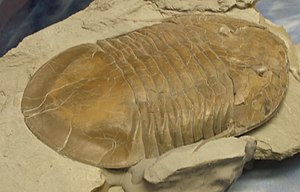Isotelus
| Isotelus | ||||||||||
|---|---|---|---|---|---|---|---|---|---|---|

Isotelus brachycephalus in the Natural History Museum in Milan |
||||||||||
| Temporal occurrence | ||||||||||
| Middle to Upper Ordovician | ||||||||||
| approx. 472 to 443.7 million years | ||||||||||
| Locations | ||||||||||
|
||||||||||
| Systematics | ||||||||||
|
||||||||||
| Scientific name | ||||||||||
| Isotelus | ||||||||||
| DeKay , 1824 |
Isotelus is a genus of asaphid trilobites from the Middle and Upper Ordovician of North America and Eurasia. The kind Isotelus rex was a length of well over half a meter of the largest known trilobite of the Earth's history .
general characteristics
The flat body of Isotelus was characterized by eight thoracic segments . The cephalon (head shield) and pygidium (tail shield) were quite large in relation to the thorax and clearly separated from it. The eyes were medium in size. Isotelus was quite common and lived on the sea floor ( epibenthal ) as a predator and scavenger .
List of scientifically described species
- Isotelus rex
- Isotelus gigas
- Isotelus maximus
- Isotelus megistos
- Isotelus parvirugosus
- Isotelus simplex
- Isotelus susae
- Isotelus walcotti
- Isotelus homalonotoides
- Isotelus iowensis
- Isotelus latior
- Isotelus brachycephalus
- Isotelus platycephalus
Isotelus rex
Isotelus rex , with a length of over 700 mm and a width of 400 mm, the largest trilobite found to date, lived during the Upper Ordovician on the floor of a shallow epicontinental sea that covered a large part of the continental core ( craton ) Laurentia , now part of the North American continent . This sea cover lasted throughout the Old Paleozoic . Laurentia was located in the Upper Ordovician near the equator and in the hot climate carbonatic sediments were deposited on the land mass flooded by a shallow sea .
The only complete find and holotype of Isotelus rex so far is known from the 445 million year old carbonate rocks on the Upper Ordovician coastline of the Churchill River Group in the north of the Canadian province of Manitoba on Hudson Bay . It was discovered in 1998 by a group of Canadian paleontologists . The length of the almost complete preserved back shield ( carapace ) exceeded that of the largest known trilobite by almost 70 percent.
State fossil

Isotelus since 1985, the "state fossil" ( State Fossil ) of the US state of Ohio .
Individual evidence
- ^ Hansen, MC 1985. “ Isotelus — Ohio's state fossil”. In: Ohio Geology Newsletter (Summer 1985) : 1-4. ODNR, Division of Geological Survey ( PDF file ( Memento of the original from May 12, 2009 in the Internet Archive ) Info: The archive link has been inserted automatically and has not yet been checked. Please check the original and archive link according to the instructions and then remove this note. )
further reading
- Rudkin, DM, GA Young, RJ Elias, and EP Dobrzanski. The world's biggest trilobite: Isotelus rex New species from the upper Ordovician of Northern Manitoba, Canada. Journal of Paleontology; 77 (1): 99-112, JSTOR 4094720 .